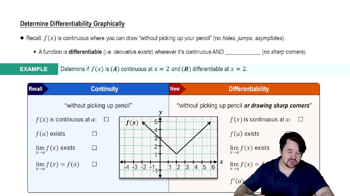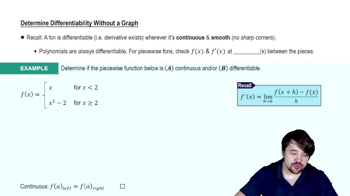Table of contents
- 0. Functions7h 52m
- Introduction to Functions16m
- Piecewise Functions10m
- Properties of Functions9m
- Common Functions1h 8m
- Transformations5m
- Combining Functions27m
- Exponent rules32m
- Exponential Functions28m
- Logarithmic Functions24m
- Properties of Logarithms34m
- Exponential & Logarithmic Equations35m
- Introduction to Trigonometric Functions38m
- Graphs of Trigonometric Functions44m
- Trigonometric Identities47m
- Inverse Trigonometric Functions48m
- 1. Limits and Continuity2h 2m
- 2. Intro to Derivatives1h 33m
- 3. Techniques of Differentiation3h 18m
- 4. Applications of Derivatives2h 38m
- 5. Graphical Applications of Derivatives6h 2m
- 6. Derivatives of Inverse, Exponential, & Logarithmic Functions2h 37m
- 7. Antiderivatives & Indefinite Integrals1h 26m
- 8. Definite Integrals4h 44m
- 9. Graphical Applications of Integrals2h 27m
- 10. Physics Applications of Integrals 2h 22m
2. Intro to Derivatives
Differentiability
Problem 53b
Textbook Question
Where is the function continuous? Differentiable? Use the graph of f in the figure to do the following. <IMAGE>
b. Find the values of x in (0, 3) at which f is not differentiable.
 Verified step by step guidance
Verified step by step guidance1
Step 1: Understand the concepts of continuity and differentiability. A function is continuous at a point if there is no interruption in the graph at that point. A function is differentiable at a point if it has a defined tangent (slope) at that point, meaning the graph is smooth and not sharp or vertical.
Step 2: Analyze the graph of the function f in the interval (0, 3). Look for any points where the graph has breaks, jumps, or holes, as these indicate points of discontinuity. Also, identify any sharp corners or vertical tangents, as these indicate points where the function is not differentiable.
Step 3: Identify any points of discontinuity in the interval (0, 3). If the graph is continuous throughout this interval, then there are no points of discontinuity.
Step 4: Identify any points where the function is not differentiable in the interval (0, 3). These could be points where the graph has sharp turns or vertical tangents.
Step 5: List the values of x in the interval (0, 3) where the function is not differentiable, based on your analysis of the graph.
 Verified video answer for a similar problem:
Verified video answer for a similar problem:This video solution was recommended by our tutors as helpful for the problem above
Video duration:
1mPlay a video:
Was this helpful?
Key Concepts
Here are the essential concepts you must grasp in order to answer the question correctly.
Continuity
A function is continuous at a point if the limit of the function as it approaches that point equals the function's value at that point. This means there are no breaks, jumps, or holes in the graph of the function at that location. For a function to be continuous over an interval, it must be continuous at every point within that interval.
Recommended video:

Intro to Continuity
Differentiability
A function is differentiable at a point if it has a defined derivative at that point, which means the function must be smooth and not have any sharp corners or vertical tangents. If a function is not continuous at a point, it cannot be differentiable there. Differentiability implies continuity, but the reverse is not necessarily true.
Recommended video:

Finding Differentials
Critical Points
Critical points are values of x where the derivative of a function is either zero or undefined. These points are important for determining where a function may not be differentiable, such as at corners, cusps, or vertical tangents. Identifying critical points helps in analyzing the behavior of the function and understanding its graph.
Recommended video:

Critical Points

 5:02m
5:02mWatch next
Master Determining Differentiability Graphically with a bite sized video explanation from Callie
Start learningRelated Videos
Related Practice



